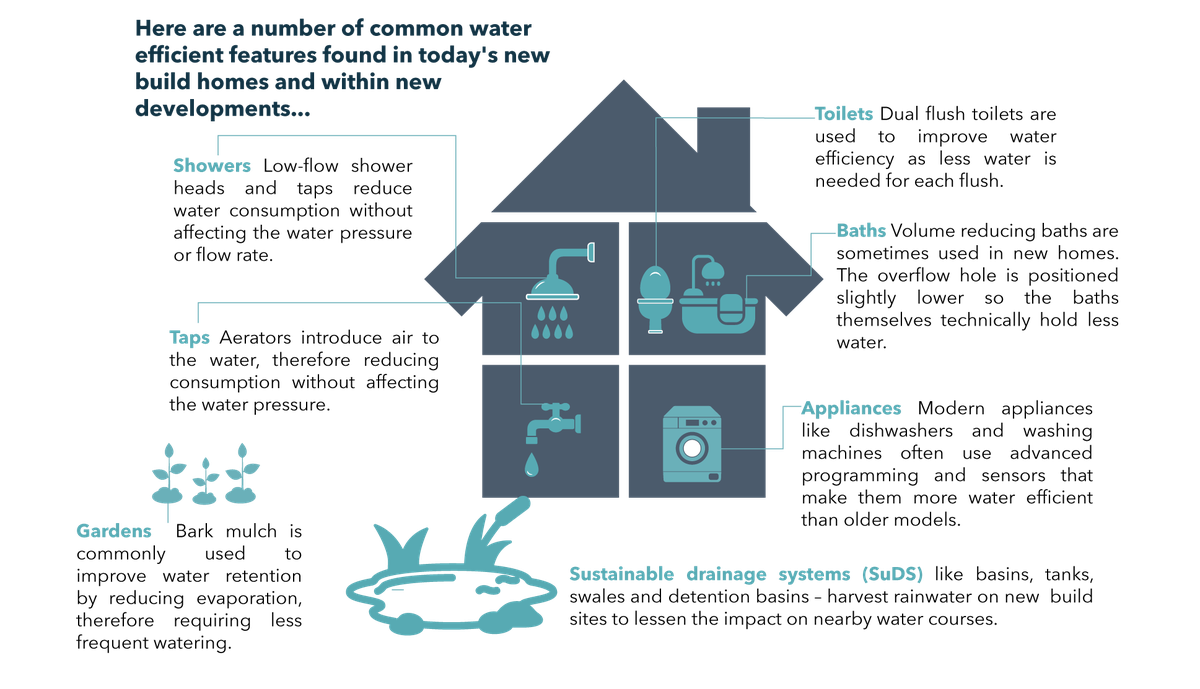Last updated: 25 Nov 2024
The water efficiency of new build homes
Introduction
As a result of climate change and population growth, the pressure on water resources has significantly increased and we face a severe shortfall in the coming years unless swift action is taken.
The impact on home building is already filtering down.
The Environment Agency has advised against multiple new housing schemes due to pressure on local water supply, for example in Cambridge and Sussex. While these issues have so far been able to be resolved, the pressures and delays are likely to start to crop up in other regions.
The home building industry is committed to playing its part in reducing the country’s water use and, as the report demonstrates, billions of litres of water are being saved each year by the purchasers of new build homes. The industry is going above and beyond current regulations and nearly all new homes are built to an average of 110 litres per person per day (LPPPD).
Water supply
New build properties are reducing water usage by almost 8.5 billion litres a year, thanks for new technologies and products and evolving building regulations.
The average property in the UK uses around 150 litres of water per person per day (LPPPD), with the average household (2.4 people) totalling 130,000 litres of water per year. In comparison, new build homes use an average of 110 litres per person per day, totalling 96,000 per year.
Scaling the savings up for the 240,000 new homes built last year, almost 8.5 billion litres of water were saved thanks to the efficiency measures embedded into new build designs.
This is the equivalent of 3,360 Olympic-sized swimming pools.
Financial impact
These water savings translate into financial savings for purchasers of new build homes. The average water bill for an existing property is £473 a year, but for new builds, that are fitted with water meters and use significantly less water, this drops to £347.
TABLE ONE: WATER SPEND USAGE AND SAVINGS IN (£)
Policy and regulatory context
Approved Document G, which accounts for water efficiency, was introduced in 2010 and requires that the average water usage of a new home (including those created by a change of use) is no more than 125 litres per person per day or 110 litres/person/day if required as part of planning permission. The majority of new homes are already being built to this 110 target.
The 25 Year Environment Plan, published under the May Government in 2018 set out a range of measures to incentivise greater water efficiency, including targets for reducing personal consumption. In 2021, the Government’s response to the consultation on environmental targets confirmed an ambition to reduce the use of public water supply in England per head of population by 20% by 2037.
The Future Homes Hub, which brings together stakeholders across the home building sector to ensure collaboration across the industry and the government’s environmental goals, published the ‘Water Ready’ report in 2024, laying out a framework for water efficiency requirements over the next 10 years. The roadmap outlines the recommended future standards for LPPPD at 2025, 2030 and 2035 as 105, 100 and 90 respectively, with even more ambitious targets in water stressed areas.
Why are new builds more water efficient?
Here are a number of common water efficient features found in today's new build homes and within new developments:
- Low-flow shower heads and taps reduce water consumption by introducing air into the flow without weakening the water pressure or flow rate.
- Dual flush toilets are used to improve water efficiency as less water is needed for each flush.
- Volume reducing baths are sometimes used in new homes. This is where the overflow hole is slightly lower so the baths themselves technically hold less water.
- Modern appliances like dishwashers and washing machines often use advanced programming and sensors that make them more water efficient than older models.
- Bark mulch is commonly used to improve water retention by reducing evaporation, therefore requiring less frequent watering.
- Sustainable drainage systems (SuDS) - like basins, tanks, swales and detention basins – harvest rainwater on new build sites to lessen the impact on nearby water courses.

TABLE TWO: WATER USAGE AND SAVINGS IN LITRES (L)
Numbers based on:
- Annual saving per person = 14,600L
- Annual saving per household (2.4 people) = 35,040L
Conclusion
Home builders have taken significant strides forward to improving the water efficiency of the nation’s housing stock. On average, new build homes are helping to save water consumption by almost 8.5 billion litres a year.
Further water savings are to be anticipated in the 10 years from 2025 as developers strive to make further reductions, but it is critical that this work is met by sufficient foresight and transitional arrangements from the Government. Too often, new building regulations are brought in with details confirmed at the last minute, which can throw projects off timelines and delay housing delivery.